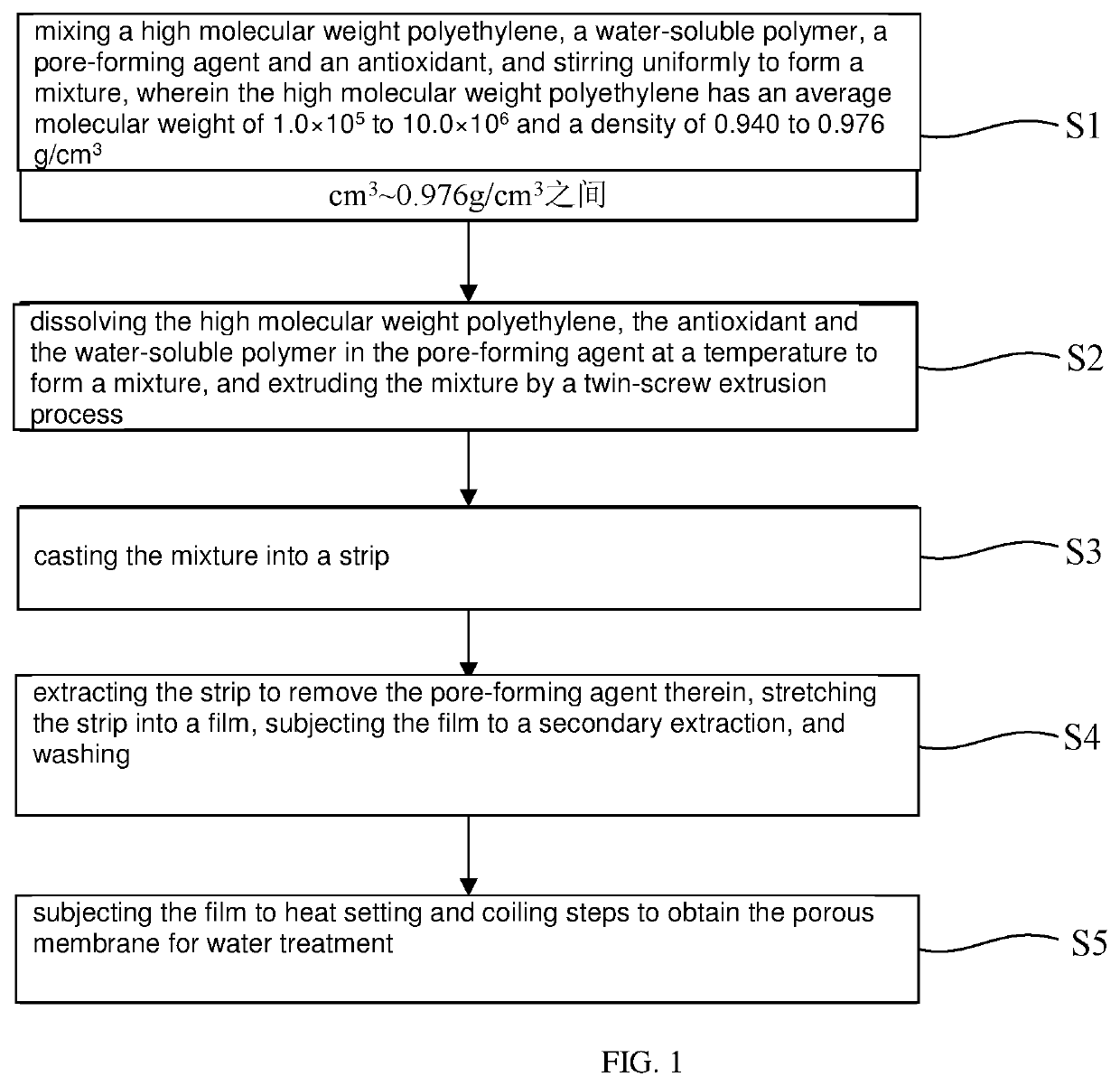Porous membrane for water treatment and method for preparing the same
a porous membrane and water treatment technology, applied in the direction of membranes, cell components, cell component details, etc., can solve the problems of poor durability, thin thickness, poor hydrophilic properties, etc., to improve the hydrophilic properties, improve the durability and reduce the thickness of the porous membrane
- Summary
- Abstract
- Description
- Claims
- Application Information
AI Technical Summary
Benefits of technology
Problems solved by technology
Method used
Image
Examples
example 2
[0073]100 g of high molecular weight polyethylene having a density of 0.957 g / cm3 and an average molecular weight of 5.0×105, 0.5 g of dibutylhydroxytoluene (an antioxidant), 10 g of polyethylene oxide, and 250 g of mineral oil were added to a continuous mixing and charging kettle, and stirred at a speed of 50 rpm to mix the raw materials uniformly.
[0074]The mixture was continuously added to a twin-screw extruder, and the high molecular weight polyethylene, the antioxidant and the polyethylene oxide were continuously dissolved in the mineral oil in the twin-screw extruder at 180° C., and continuously extruded by the twin-screw extruder at a speed of 200 rpm. The mixture was continuously introduced into a slit die, and extruded through the slit die to a cooling cast roller and cast into a strip at 80° C.
[0075]The obtained strip was placed in an extraction tank containing dichloromethane for extraction to remove the mineral oil from the strip. The extracted strip was continuously fed ...
example 3
[0076]100 g of high molecular weight polyethylene having a density of 0.957 g / cm3 and an average molecular weight of 5.0×105, 0.5 g of dibutylhydroxytoluene (an antioxidant), 15 g of polyethylene oxide, and 250 g of mineral oil were added to a continuous mixing and charging kettle, and stirred at a speed of 50 rpm to mix the raw materials uniformly.
[0077]The mixture was continuously added to a twin-screw extruder, and the high molecular weight polyethylene, the antioxidant and the polyethylene oxide were continuously dissolved in the mineral oil in the twin-screw extruder at 180° C., and continuously extruded by the twin-screw extruder at a speed of 200 rpm. The mixture was continuously introduced into a slit die, and extruded through the slit die to a cooling cast roller and cast into a strip at 80° C.
[0078]The obtained strip was placed in an extraction tank containing dichloromethane for extraction to remove the mineral oil from the strip. The extracted strip was continuously fed ...
example 4
[0079]100 g of high molecular weight polyethylene having a density of 0.957 g / cm3 and an average molecular weight of 5.0×105, 0.5 g of dibutylhydroxytoluene (an antioxidant), 25 g of polyethylene oxide, and 250 g of mineral oil were added to a continuous mixing and charging kettle, and stirred at a speed of 50 rpm to mix the raw materials uniformly.
[0080]The mixture was continuously added to a twin-screw extruder, and the high molecular weight polyethylene, the antioxidant and the polyethylene oxide were continuously dissolved in the mineral oil in the twin-screw extruder at 180° C., and continuously extruded by the twin-screw extruder at a speed of 200 rpm. The mixture was continuously introduced into a slit die, and extruded through the slit die to a cooling cast roller and cast into a strip at 80° C.
[0081]The obtained strip was placed in an extraction tank containing dichloromethane for extraction to remove the mineral oil from the strip. The extracted strip was continuously fed ...
PUM
| Property | Measurement | Unit |
|---|---|---|
| density | aaaaa | aaaaa |
| surface contact angle | aaaaa | aaaaa |
| porosity | aaaaa | aaaaa |
Abstract
Description
Claims
Application Information
 Login to View More
Login to View More - R&D
- Intellectual Property
- Life Sciences
- Materials
- Tech Scout
- Unparalleled Data Quality
- Higher Quality Content
- 60% Fewer Hallucinations
Browse by: Latest US Patents, China's latest patents, Technical Efficacy Thesaurus, Application Domain, Technology Topic, Popular Technical Reports.
© 2025 PatSnap. All rights reserved.Legal|Privacy policy|Modern Slavery Act Transparency Statement|Sitemap|About US| Contact US: help@patsnap.com

